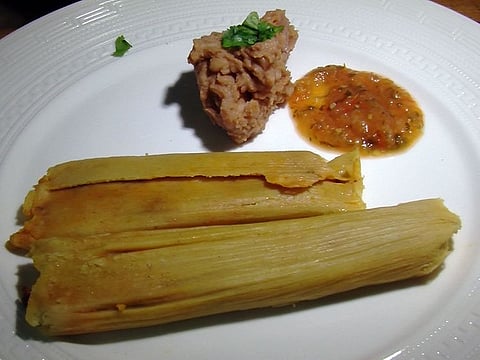How to make the famed 2000-year-old Mexican corn tamales
A blend of cornmeal, meat and the silken Guajillo chillies, tamales are a must-try recipe

Latin American cuisine is rich, wide and variated as the diversity of climates, native cultures, conquest, trade and immigrations of a whole continent for the last five centuries, yet, there is but one ingredient that unifies the 33 countries: Maize.
Like many other things of old, the origin of maize is lost in the mists of the times, yet archaeology and genetics point the birthplace of it to be in south-central Mexico, around 10,000 years ago and from there it found his way both north and south all the way to Tierra del Fuego, Argentina.
In Mexico, we consume maize on a daily basis, mostly after a process called nixtamalisation that turns the maize into “masa”, which like in the Mayan myth of the creation of humankind, makes the flesh of the first men of all of Latin Americans.
It is present in every meal, from breakfast to dinner and midnight snacks, in the form of totopos (tortilla chips), tortillas, popcorn, arepas, gorditas, sopes, bread, cookies etc. We even eat corn sandwiches (torta de tamal), we drink it in sweet hot beverages of corn (atole).
One of the favourites in maize-based food of the whole American continent is Tamales. In Mexico alone there is more than 400 recipes of tamales, but same as the maize, the origin of it is under debate - nobody knows if it came from south America to North, or vice versa, as it is a dish that is more than 2000 years old.
The word tamal comes from the Aztec word “Tamalli” that means “wrapped”, and it has traveled beyond Latin America due to the Columbian exchange to places like Guam and even Philippines where they have a rice base variant of the dish, yet still called tamale.
The Columbian exchange, also known as the Columbian interchange, was the widespread transfer of plants, animals, precious metals, culture, human populations, technology, diseases, and ideas between the Americas, the western hemisphere, and the Old World, the eastern hemisphere, in the late 15th and following centuries, according to online research sites.
Tamales are a common dish, but in north Mexico are primarily celebration food, especially for Christmas and birthdays. One of my fondest childhood memories was our yearly journey back to my great-grand mother’s house, in our home town, for Christmas celebrations and to see her, our native American matriarch surrounded by daughters, granddaughters and great-granddaughters, cooking this very dish, passed down for generations of women for the last two millennia.
I find myself alone in the UAE with my two sons, we don’t have our matriarchs, but my mother is back home. However, she does have internet and has shared, once again, the family recipe of our Tamales Norteños that now I will share with you:
Difficulty: Medium
Preparation: 60 minutes
Cooking time: 60 minutes
Serves: 16 tamales
Ingredients:
800 gms of chicken or beef
6 Guajillo chilies (available online – has a sweet, smoky flavour)
2 tomatoes
1/4 onion minced
1 garlic clove roasted
1 pinch of roasted cumin powder
2 cloves
1 kg of masa dough (available online)
250 gms of all-vegetable shortening
Salt to taste
Meat cooking broth (from the meat you cook)
16 corn husks for tamales (you can replace them with four big banana leaves)
Method:
The corn husk
Soak them in water for at least 30 minutes, if you decide to use banana leaves, skip this step.
Prepare the meat
1. Boil the beef or chicken with garlic and onions and salt, until tender, save the broth. Then shred the meat.
2. Remove the seeds and stringy bits from the inside the dried chilies, roast them lightly on an open flame (optional) then soak them in hot water for 15 minutes.
3. Once chilies are rehydrated and soft, add a few tablespoons of water. Then add the garlic, tomatoes, onion, clove and cumin and bring to a boil for 15 minutes.
4. Let it cool down and then blend into a fine paste.
5. Add cooking oil to a frying pan, once hot add the shredded meat, fry for two to three minutes and then add the chilli paste. Bring to a boil for 10 minutes and set aside.
Prepare the dough
1. Use a mixer to beat the shortening until it is light and creamy, the masa is incorporated little by little without stopping the beating. If you don’t have a mixer, it can be done by hand.
2. If you notice that the dough is somewhat dry, add little of the meat broth. When the dough is either detaching from the sides of the vessel, comes off the hand easily or if the beaters are completely clean, then the dough is ready.
Wrap the tamale
1. Spread the masa dough over a husk into a thin uniform layer, then add 1 spoon of meat and spread it.
2. Roll it and place it in a steamer, leave an open area in the center to allow the steam to flow better.
3. Steam them for 1 hour.
Click here for our detailed guide to tamale rolling https://gulfnews.com/food/guide-cooking/how-to-make-tamales-from-scratch---a-step-by-step-guide-1.1610966309606
Dip tip
One can of your favorite beans (pinto, black beans or red kidney beans go the best with tamales), add garlic and a pinch of cumin, salt, all added into the blender to create a mushy dip for the tamales.
Serve them with a hot spicy sauce and enjoy.
Note: This article was first published in August 2021.
Share your favourite Mexican recipe with us at food@gulfnews.com
Sign up for the Daily Briefing
Get the latest news and updates straight to your inbox









